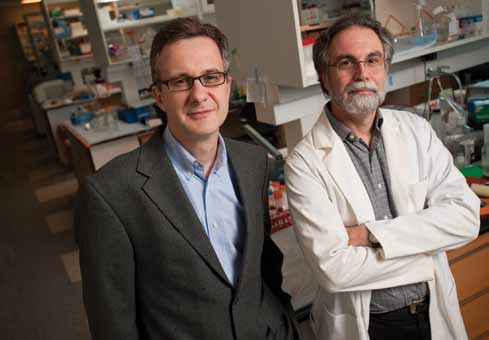
(Photo by Will Kirk)
When the Institute for NanoBioTechnology (INBT) was launched in 2006, the institute’s directors noted that its formation marked a dramatic change in the way research would be pursued at the School of Engineering and at Johns Hopkins. At the INBT, complex medical problems would be addressed by a vast array of engineers, scientists, and clinicians from Johns Hopkins’ schools of Engineering, Medicine, Public Health, and Arts and Sciences, who, working in groups, would draw upon their widely ranging skills and expertise in pursuit of common goals.
This fall, the success of this multidisciplinary approach was given wide recognition when the National Cancer Institute (NCI) awarded the INBT a $14.8 million grant to launch a new interdisciplinary research center: the Johns Hopkins Engineering in Oncology Center. Aimed at unraveling the physical underpinnings of the growth and spread of cancer, the center is one of 12 Physical Sciences-Oncology Centers being launched by the National Cancer Institute as part of a five-year initiative to bring a new cadre of theoretical physicists, mathematicians, chemists, and engineers to the study of cancer.
Denis Wirtz, the Theophilus A. Smoot Professor of Chemical and Biomolecular Engineering and associate director of the INBT, is the new center’s director and principal investigator, and Gregg L. Semenza, a leading researcher at the School of Medicine, is associate director. The new cancer center also includes 11 Johns Hopkins researchers affiliated with the INBT and four from partner institutions.
“The breadth of expertise that Johns Hopkins has to offer is unparalleled,” says Dean Nick Jones. “This funding is a testament to the value of interdisciplinary research and is recognition that creative, collaborative problem solving that we value at the Whiting School is what is needed to tackle the most complex medical issues of our time.” Jones also commended the vision of the INBT leaders in establishing the institute and expressed pleasure at the terrific return on the strategic investment directed to INBT by the four sponsoring schools.
During the five-year initiative, the NCI’s Physical Sciences–Oncology Centers will take new, nontraditional approaches to cancer research by studying the physical laws and principles of cancer; evolution and evolutionary theory of cancer; information coding, decoding, transfer and translation in cancer; and ways to de-convolute cancer’s complexity.
When the funding for the new cancer centers was announced, John E. Niederhuber, director of the NCI, said, “Physical scientists think in terms of time, space, pressure, heat, and evolution in ways that we hope will lead to new understandings of the multitude of forces that govern cancer, and with that understanding, we hope to develop new and innovative methods of arresting tumor growth and metastasis.”
In an interview with the Johns Hopkins Gazette, Wirtz explained, “Metastasis is a highly coordinated, multistep process. Cancer cells break free from a primary tumor, penetrate into the bloodstream, evade host defenses, stick to the interior walls of blood vessels, and travel to colonies. During this cascade of events, tumor cells push on and are pushed by mechanical forces within their microenvironment. Cells translate those mechanical forces into biochem- ical signals that affect cell growth and function. If we can gain a better understanding of this process, we may find new and better ways to treat cancer.”
Wirtz, working with Greg D. Longmore, a cancer cell biologist at Washington University in St. Louis, will study the physical basis for cancer cell adhesion and de-adhesion and how it increases the likelihood that cancer cells will break free, move into the bloodstream, and migrate to other tissues.
Semenza and Sharon Gerecht, an assistant professor of chemical and biomolecular engineering, will lead another of the center’s three key research projects, focusing on analysis of the makeup and physical properties of the extracellular matrix, the three-dimensional scaffold in which cells live.
Konstantinos Konstantopoulos, professor and chair of WSE’s Department of Chemical and Biomolecular Engineering, and Martin L. Pomper, from the Department of Radiology at the School of Medicine and the Kimmel Cancer Center, will lead the third key research area, investigating the effects of fluid mechanical forces at different oxygen tension microenvironments on tumor cell signaling, adhesion, and migration.




